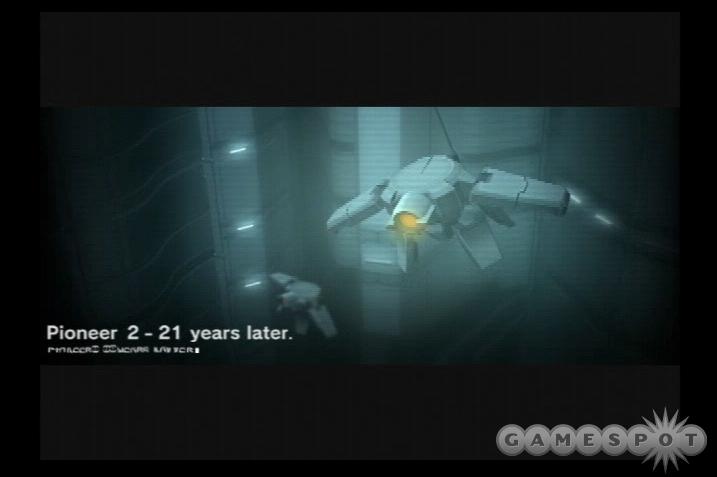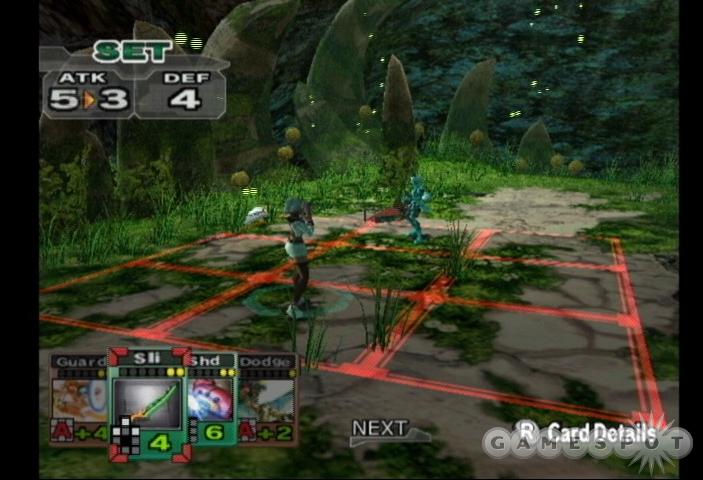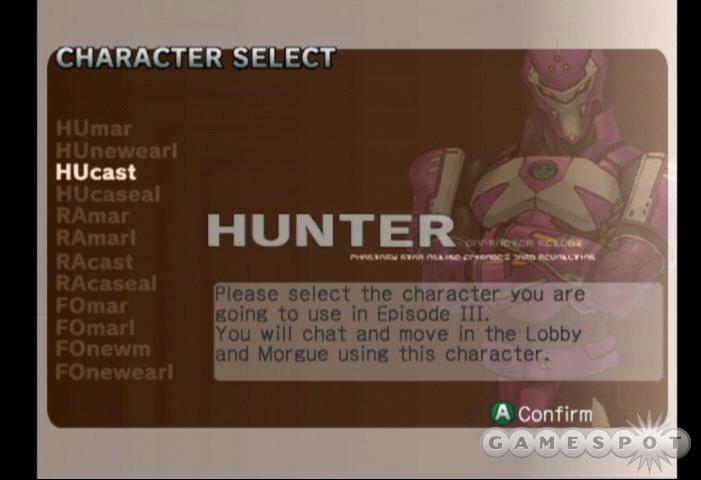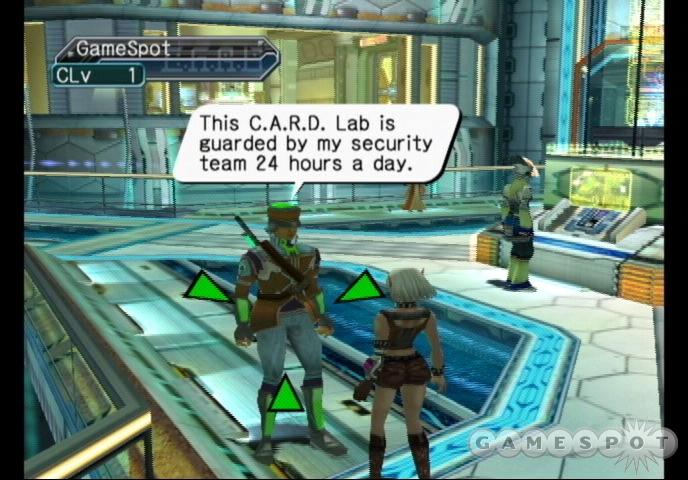Phantasy Star Online Episode III: C.A.R.D. Revolution Preview
We try out the domestic version of Sega and Sonic Team's unique new entry in the Phantasy Star series.
Despite the fact that Sega's Phantasy Star series only had four installments, the last of which was released in 1993, the franchise has had a strong enough following to warrant a revival in 2000. Sonic Team's Phantasy Star Online for the Dreamcast offered a groundbreaking online RPG experience for home consoles and introduced Phantasy Star to a new wave of players. The game's popularity was enough to justify new entries on the GameCube and Xbox after the DC's demise. For the third and latest entry in the series, Sonic Team has taken the series in a completely new direction. Phantasy Star Online Episode III: C.A.R.D. Revolution offers a unique new way to adventure in the Phantasy Star Online world, thanks to the introduction of a new card battle system. We had the chance to try out the domestic version of the game to see how the change in style works for the series.

Phantasy Star Online Episode III: C.A.R.D. Revolution's story will once again be set against the backdrop of the mysterious planet Ragol and the massive Pioneer 2 spaceship, which is loaded with potential colonists in orbit. This time out, Sonic Team has opted to put a stronger emphasis on the story in the game, which was pretty thin in the previous installments. The game takes place 21 years after the events in the last two episodes of Phantasy Star Online Episodes I & II. While you'd think you'd check in to find the colonists all settling in to life on Ragol, that's not the case. The gang is still stuck on the ship, biding its time. The reasons behind the delay are due to a bit of X-Files-like mystery, which revolves around the government. The original principal, Tyrell, has been replaced by a new leader, whose hands are now full due to the appearance of the arkz, a rebel faction that has emerged to oppose the government in hopes of finally allowing the colonists to begin life on Ragol. The narrative unfolds over the course of two distinct storylines--one that follows the "hunter" and one that follows the "arkz"--which you can pursue. Each gives you different perspectives on the whole situation. One thing to note about the story and the game is that Sonic Team is billing this as the final entry in the PSO story arc.
You'll find two main game modes in Phantasy Star Online Episode III: C.A.R.D. Revolution--offline and online. The offline game lets you choose to go through the game in the hunter or arkz storyline, or you can try out a free battle that lets you play your own custom match against an AI or human opponent. The online game lets you challenge opponents from around the world. You're able to engage in one-on-one battles or larger matches of two-on-two. In addition to these standard battles, you're able to engage in tournaments, you can trade cards, and you can earn some rare cards for your decks. As with Episode I & II, you'll need to buy a hunter's license to play online. However, if you currently have a valid hunter's license for that game, you're able to use it to play Episode III online at no extra charge.
The game's structure is pretty similar to the previous PSO games in that you'll have to create a virtual avatar, interact with other characters, take on missions, engage in combat, level up, and work from a central hub. However, the specific mechanics have changed since the first game. Your virtual avatar is basically your "face" when you're roaming the hub area (oddly called "the morgue" in the game) and playing online. You'll have to create your face from scratch when you start the game because your data from the previous one won't transfer over. The character creation process is exactly the same as it's been in previous entries in the series. You'll find three main classes to choose from--hunter, ranger, and force--each with gender and species variations. You're able to customize your character's face, hair, costume, skin color, proportion, and name. Once you have your character sorted, you're dropped into the morgue and must begin talking to the nonplayer characters around you. You'll meet your leader, check out your base area, (and both will vary depending on the storyline you play), and then set out on your mission.

The twist to taking on missions is that you're positioned as the team leader or tactician, much the same way that Fire Emblem on the Game Boy Advance pulls you into its story. As a result, you're there to provide direction and leadership during battle, so you'll actually be sending other characters into the fray and issuing orders to them. You'll start out with a simple three-person team, and each member will represent one of the main classes. The classes still have the same basic proficiencies, though this is reflected in the decks of cards used and the skill shown by each. The cards break down into four major groups: item, action, creature, and assist. Item cards provide you with offensive articles, such as weapons; defensive weapons, such as shields; or stat-enhancing articles, such as mags. Action cards furnish you with physical attacks, technique attacks (basically elemental magic attacks), and defensive moves, like the ability to dodge. Creature cards let ark characters summon monsters to fight on their behalf. Finally, assist cards offer a variety of support effects. Which cards you can use will differ based on which storyline you choose.
By choosing to join the hunter or ark forces, you're committing to a specific style of play. Hunters have the ability to use item cards but cannot use creature cards, while arks can use creature cards but cannot use item cards. Both sides can use the action and assist cards. These differences come into play during the card battle, which now replaces the real-time combat from the previous game.
The matches begin with a roll of the dice to determine who takes the first turn. Each turn in a match consists of five general phases, which are played through on either side until one player wins or time runs out. The first phase of a turn is the dice roll. Two dice are rolled, and the higher number determines your "ATK points," which dictate how many actions you can perform during your turn. The lower number determines your "DEF points," or the level of defense you'll have against any subsequent attacks. The second phase of your turn lets you equip items or summon monsters, depending on whether you chose to be a hunter or an ark. Different equipment and summons cost various amounts of ATK points. For instance, determining whether or not you can successfully equip an item or summon a creature depends on how many points you've rolled.

The third phase of your turn lets you move your character. Hunter characters and summoned monsters can generally move one space per ATK point, though larger creatures can't move quite as far as smaller ones. The fourth phase lets you or one of your monsters attack by using your ATK points with each assault. You can also use action cards in this phase of your turn to supplement your attacks, and each has a specific ATK cost as well. The fifth and final phase lets you discard any unnecessary cards, and then you can draw new ones from your deck. At this point, you'll then wait for your opponent's turn.
When you're attacked during an opponent's turn, you have the option to use one of your cards to defend yourself, if you have one handy. The differences between hunters and arkz can be blessings and curses in combat, depending on your style of play. Hunters have a slight advantage over arkz when attacked because equipped items, such as weapons, mags, and shields, take the brunt of inflicted damage, thus allowing them to take more damage in the long run. However, arkz also have an exploitable benefit. Thanks to the creatures they can summon--which can subsequently be placed in an opponent's way--arkz can ensure that they're not harmed during combat. However, arkz must hope that their cards hold out when employing this strategy.
If you're familiar with card games, you should be able to pick up PSO's battle system pretty quickly, thanks to its logical structure. If you're new to card-battling, it may take you a while to get comfortable with the whole system, but practicing in free battle and viewing the in-game tutorial should bring you up to speed pretty quickly. One of the main draws of the game will likely be the collection factor, since every victory earns you new cards to work into your various decks, in addition to new team members who will have their own unique decks. You'll also earn experience points that increase your card level, which lets you earn higher level cards in the game.
The graphics in the game represent a marked improvement over the previous PSO on the GameCube, thanks to a higher level of detail and larger characters in battle. The confined spaces where you'll battle--since combat takes place on gridlike areas in familiar locales on Ragol--have allowed Sonic Team to bump up the overall graphical quality. While the characters and assorted creatures look better, the environments really shine this time out. Old locales have been polished up some, and new environments include impressive little touches, such as particle effects and diffuse lighting. A new graphical element included in the mix is hand-drawn comic-style cinematics that are used to move the narrative along in key places. The segments add a nice, fresh touch to the presentation.

The game's audio blends familiar effects for creatures, assorted attacks, and menu options with a new soundtrack that's nicely epic. You'll hear a lot of the same effects for monsters, weapons fire, and icon-based chat, which adds a certain level of familiarity that's actually welcome. In addition to the familiar elements, you'll hear some new material, such as an announcer and a new hub theme, as you explore the morgue. The overall package is solid, although it's uninspired in some places. Unfortunately, the hub music definitely lacks the appeal of its predecessor, and the announcer is extremely bland.
From what we've played of Phantasy Star Online Episode III: C.A.R.D. Revolution, it will definitely represent a unique entry in the PSO franchise. However, whether or not this is a good thing remains to be seen. While we liked the combat--once we got a handle on it--having the option to speed up the pacing of the battles by cutting out animation or by not forcing you to wait through the various phases of your opponent's turn would be nice. We will say we're intrigued by the offline story mode, which is considerably more fleshed out than the previous game and has a lot to offer. Overall, we're still not sure if this is the way fans of the PSO series will want to see it wrapped up. Still, if you're looking for a solid card game with online play, you'll want to look out for Phantasy Star Online Episode III: C.A.R.D. Revolution when it ships this March for the GameCube.
Got a news tip or want to contact us directly? Email news@gamespot.com
Join the conversation